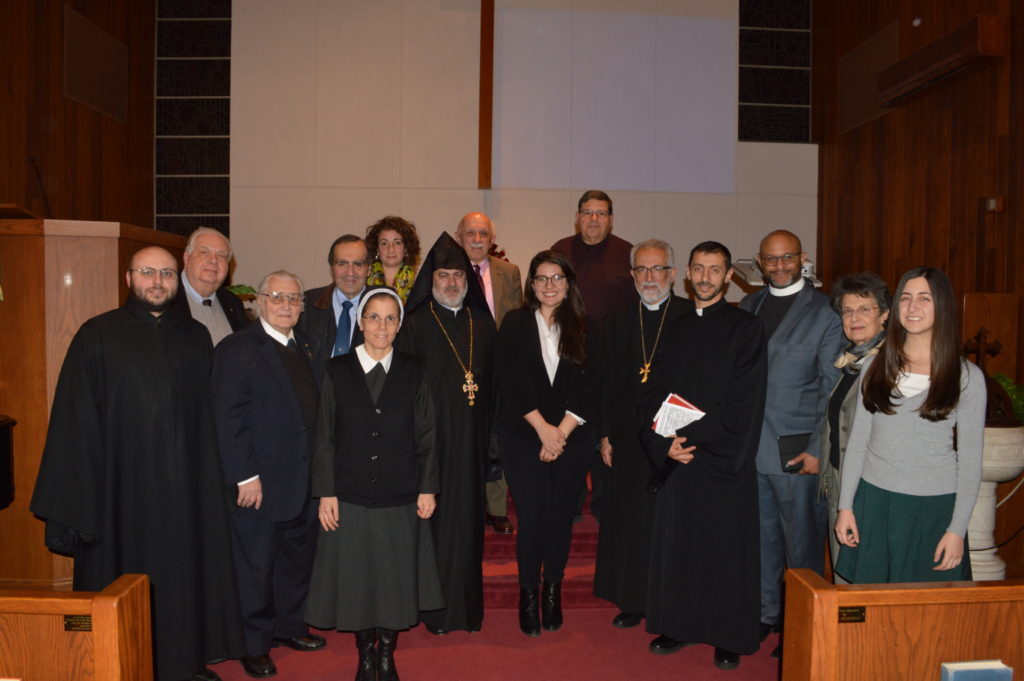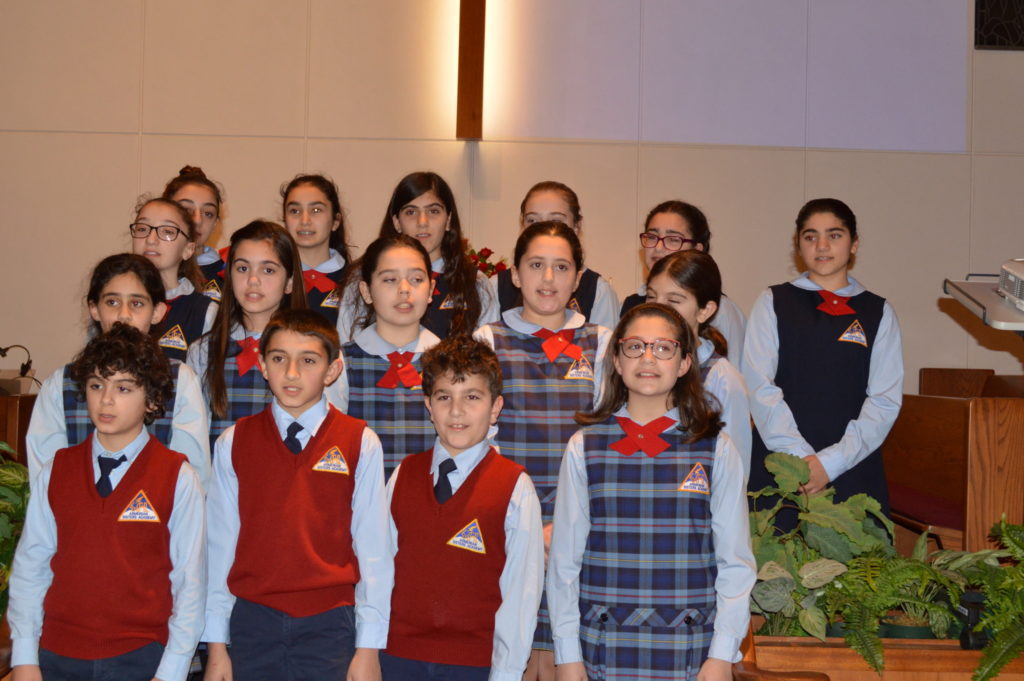
PHILADELPHIA (A.W.)—The Armenian Inter-Communal Committee of Philadelphia, a consortium of lay and religious representatives of the five Armenian churches and one Armenian day school in the greater Philadelphia area, has for over 40 years been committed to keeping open a dialogue among local Armenians with each other and with their heritage, as well as being a powerful unified Armenian presence in the broader metropolitan area.
Each year it organizes three commemorations of three historic events: Vartanants in February, the Armenian Genocide in April, and Tarkmanchats [Translators’ Day] in October. The challenge to be relevant and bring fresh perspective keeps the Committee on the lookout for individuals and groups who have something novel to contribute to this ongoing cultural conversation.
So far in 2018, two refreshingly different and thought-provoking events have taken place, encouraging the local Armenian community to think newly and commemorate actively.
Feb. 8 brought to the sanctuary of Armenian Martyrs’ Congregational Church in Havertown the illustrated talk “Visualizing Vardan(ants): Avarayr Illuminated, 14th-17th Centuries” presented by art historian and Princeton University Department of Art and Archaeology doctoral student Erin Piñon. With passion and expertise, she shared her own insatiable wonder/love regarding the artistic interpretations through the ages of this battle and her readiness to journey literally to wherever research beckoned.
How Armenians of the past have commemorated the event through artwork is a unique phenomenon of a history being illuminated in manuscripts, some as very small texts which provide an intimate experience for the one person holding them. Ms. Piñon introduced us to the term sharakan as an illuminated hymn and made the case for the absence of Vartanants-related artwork until the 12th century when Nerses Shnorhali picked up the story. “These illuminations echo the praise-worthy words of the sharakans.”

She had us viewing details in new ways: gold outlines of figures of soldiers were an adorning of their martyrdom, the gold trim essentially extending the lives of these martyrs. Armenians are always depicted as superior in combat. The soldier becomes the saint, the victim the victorious, the slaughtered the saved. Ms. Piñon delighted being among an audience of contemporary Armenians bringing life again to what she has been studying in a scholastic bubble.

April 24 found us in Memorial Hall of Sts. Sahag and Mesrob Armenian Apostolic Church in Wynnewood, riveted by Dr. Haik Demoyan’s presentation “Aurora’s Road: The Mission of the Armenian Genocide Survivor.” Director of the Armenian Genocide Museum-Institute in Yerevan and Chief Editor of the International Journal of Armenian Genocide Studies, Dr. Demoyan is currently a U.S. Fulbright Visiting Scholar at Harvard’s Davis Center for Russian and Eurasian Studies, where he is engaged in researching the identity transformation processes in the South Caucasus. He reminded us that the Armenian legacy in America spans 400 years of heritage, from Martin the Armenian’s arrival in Jamestown, Va. in 1618.
Coincidentally, Dr. Demoyan remarked, 2018 also commemorates the 100th anniversary of the establishment of the first Armenian Republic and the 2800th anniversary of the founding of the city of Yerevan. He then proceeded to bring to life the journey of Genocide-survivor Arshalouys Mardiganian’s story in poignant detail, as an illustration of the work his Institute is doing: “We translate… we must save what we can save… We Armenians have to care about our heritage because it’s part of our history.”
Dr. Demoyan concluded with spontaneous comments on the current sociopolitical situation unfolding in Armenia: “As an intellectual, I can’t take sides, but I can’t remain neutral either… It’s about joining an energy–not about hatred or unseating someone… I am full of hope for the future… The new generation are the decision-makers. We have to respect young people’s right to think differently… History shows us we don’t like leaders, so we will be led by multiple leaders.”
Keeping with tradition, each Inter-Communal event included students from the Armenian Sisters Academy bringing their full and endearing participation to the program with their songs and recitations. Their presence is always a gift from the future, for they represent the hope that there will be yet another generation filling their shoes. Indeed, many of them have parents who a generation ago stood in their same places singing and reciting.

(Photo courtesy of Dr. Arsine Oshagan)
The remaining event of our 2018 season is planned for Oct. 7 at St. Gregory the Illuminator Armenian Apostolic Church in Philadelphia and will feature Dr. Helen C. Evans, Byzantine Art Curator at the Metropolitan Museum of Art in New York City, who will speak about the upcoming unprecedented exhibition “Armenia!” Scheduled to open on the 27th anniversary of the Republic of Armenia’s independence, Sept. 21, this large-scale exhibition dedicated solely to the Armenian history and culture in the medieval period will cover the 4th to 17th century and will portray the significance of Armenian art to the world during the Middle Ages. It will remain on exhibit until January 13, 2019 and will feature some 140 Armenian works of art from around the globe, including artwork on loan from Yerevan’s Madenataran (the Mesrop Mashtots Institute of Ancient Manuscripts) and the History Museum of Armenia, the Mother See of Holy Echmiadzin, the Jerusalem Patriarchate, the Holy See of Cilicia in Antelias, the Mekhitarist Monastery in Venice, the Calouste Gulbenkian Museum in Portugal, the Alex and Marie Manoogian Museum in Detroit, the Armenian Museum of America in Watertown, and the Eastern Diocese of the Armenian Church in New York.
Dr. Evans, who wrote her doctoral dissertation on the Armenian manuscripts of Cilicia, has taught courses on Armenian art at Columbia University and currently serves as president of The International Center for Medieval Art. She has wanted to curate such an exhibition since coming to the Met over 30 years ago.
It is with excitement that the Philadelphia Armenian community—including the other two participating parishes of Holy Trinity Armenian Apostolic Church of North Philadelphia and St. Mark’s Armenian Catholic Church of Wynnewood—looks forward to this Fall event. And it is with profound gratitude and inspiration that we appreciate the scholars who have graced our venues this year, sharing their life’s work and bringing us to new awareness of and connection with our source—our heritage—our legacy.
The post New Possibilities for an Ancient People: When Scholarship, Art, History, Faith, and Community Intersect appeared first on The Armenian Weekly.
Source: Armenian Weekly
Link: New Possibilities for an Ancient People: When Scholarship, Art, History, Faith, and Community Intersect
